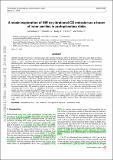Files in this item
Model exploration of near-IR ro-vibrational CO emission as a tracer of inner cavities in protoplanetary disks
Item metadata
| dc.contributor.author | Antonellini, S. | |
| dc.contributor.author | Banzatti, A. | |
| dc.contributor.author | Kamp, I. | |
| dc.contributor.author | Thi, W. F. | |
| dc.contributor.author | Woitke, P. | |
| dc.date.accessioned | 2020-10-23T16:30:03Z | |
| dc.date.available | 2020-10-23T16:30:03Z | |
| dc.date.issued | 2020-05 | |
| dc.identifier | 269495718 | |
| dc.identifier | 7813deef-7624-4efa-a5b0-fe3dbf5988f4 | |
| dc.identifier | 85088697089 | |
| dc.identifier | 000619918200001 | |
| dc.identifier.citation | Antonellini , S , Banzatti , A , Kamp , I , Thi , W F & Woitke , P 2020 , ' Model exploration of near-IR ro-vibrational CO emission as a tracer of inner cavities in protoplanetary disks ' , Astronomy and Astrophysics , vol. 637 , A29 . https://doi.org/10.1051/0004-6361/201834077 | en |
| dc.identifier.issn | 0004-6361 | |
| dc.identifier.uri | https://hdl.handle.net/10023/20814 | |
| dc.description | The author is grateful to the STFC for support through grant number ST/P000321/1. | en |
| dc.description.abstract | Context. Near-IR observations of protoplanetary disks provide information about the properties of the inner disk. High-resolution spectra of abundant molecules such as CO can be used to determine the disk structure in the warm inner parts. The v2∕v1 ro-vibrational ratio of v1−0 and v2−1 transitions has recently been observed to follow distinct trends with the CO emitting radius in a sample of TTauri and Herbig disks; these trends have empirically been interpreted as due to depletion of the inner disk from gas and dust. Aims. We use thermochemical disk models to explore the to interpret the trends of these CO ro-vibrational CO emission. Methods. We used the radiation thermochemical code ProDiMo to explore a set of previously published models with different disk properties and varying one parameter at a time: the inner radius, the dust-to-gas mass ratio, and the gas mass. In addition, we used models in which we changed the surface density power-law index, and employed a larger set of CO ro-vibrational levels that also include fluorescence from the first electronic state. We investigated these models for TTauri and Herbig star disks. Finally, we included a set of DIANA models for individual TTauri and Herbig disks that were constructed to reproduce a large set of multiwavelength observations. Results. This modeling exploration highlights promising parameters that may explain the observed trends in ro-vibrational CO emission. Our models with an increasing inner radius match the observed trend for TTauri disks, in which we were also able to account for the vertical spread in the data by different values for the dust-to-gas mass ratio and for the disk gas mass in different disks. Our models instead match the CO vibrational ratio observed in Herbig disks only in the case of large inner holes and cannot produce the low ratios that are measured in many disks. The models do produce an inversion in the trend, where v2−1∕v1−0 increases and does not decrease for CO radii larger than a few au. The reason for this is that the P(4) v2−1 line becomes optically thin and superthermally excited. In our models, this does not require invoking UV fluorescence pumping. Conclusions. Our modeling explorations suggest that the observed decrease in v2−1∕v1−0 with CO radius in TTauri disks might be a consequence of inside-out disk depletion. For the Herbig disks, a more complex inner disk structure may instead be needed to explain the observed trends in the excitation of CO emission as a function of emitting radius: disk gaps emptied of dust, partially depleted in gas, and/or possibly a disk structure with an inverted surface density profile. These structures need to be further investigated in future work. | |
| dc.format.extent | 11 | |
| dc.format.extent | 1297967 | |
| dc.language.iso | eng | |
| dc.relation.ispartof | Astronomy and Astrophysics | en |
| dc.subject | Line: profiles | en |
| dc.subject | Protoplanetary disks | en |
| dc.subject | Stars: pre-main sequence | en |
| dc.subject | QB Astronomy | en |
| dc.subject | QC Physics | en |
| dc.subject | Space and Planetary Science | en |
| dc.subject | Astronomy and Astrophysics | en |
| dc.subject | NDAS | en |
| dc.subject.lcc | QB | en |
| dc.subject.lcc | QC | en |
| dc.title | Model exploration of near-IR ro-vibrational CO emission as a tracer of inner cavities in protoplanetary disks | en |
| dc.type | Journal article | en |
| dc.contributor.institution | University of St Andrews. School of Physics and Astronomy | en |
| dc.contributor.institution | University of St Andrews. St Andrews Centre for Exoplanet Science | en |
| dc.identifier.doi | 10.1051/0004-6361/201834077 | |
| dc.description.status | Peer reviewed | en |
| dc.identifier.url | https://arxiv.org/abs/2003.11788v1 | en |
This item appears in the following Collection(s)
Items in the St Andrews Research Repository are protected by copyright, with all rights reserved, unless otherwise indicated.

